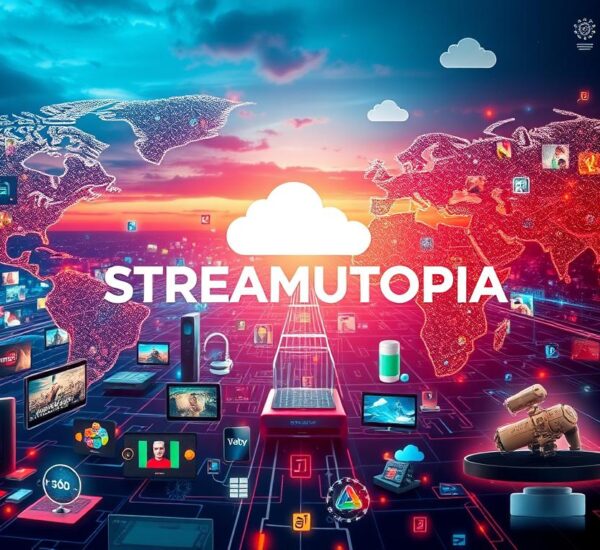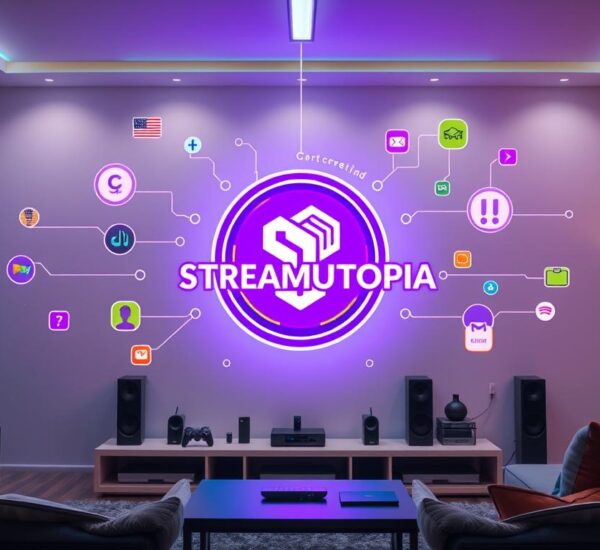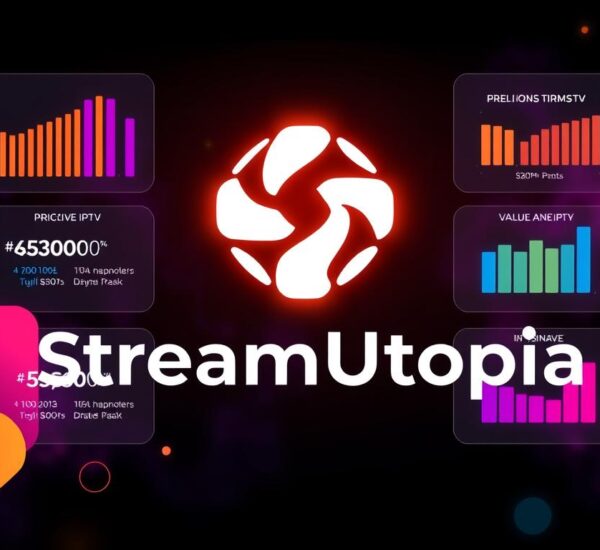Did you know that 5G technology is revolutionizing the global video streaming industry, paving the way for streaming in resolutions as high as 4K and 8K? With its ability to support higher bit rates and greater bandwidth, 5G is set to transform the way we consume video content.
Key Takeaways:
- 5G technology enables streaming in resolutions as high as 4K and 8K, providing sharper and more detailed video content.
- 5G offers faster upload and download speeds, decreased latency, and improved connectivity, enhancing the overall streaming experience.
- Content Delivery Networks (CDNs) play a crucial role in a 5G environment, ensuring efficient video delivery and managing increased traffic demand.
- 5G revolutionizes the user experience in video streaming with faster loading times, smoother playback, and support for interactive and immersive streaming experiences.
- The future of video streaming is poised for exciting developments with 5G, including personalized content delivery, support for new formats and technologies, and changes to business models.
The Influence of 5G on Video Streaming
5G technology is revolutionizing video streaming with its impact on higher bit rates, greater bandwidth, and resolutions up to 4K and 8K. The introduction of 5G allows for faster upload and download speeds, more robust mobile connectivity, and decreased latency, resulting in a significantly improved streaming experience.
With 5G’s ability to support higher bit rates and greater bandwidth, video streaming is reaching new heights. Streaming in resolutions as high as 4K and 8K provides users with sharper, more detailed video content, enhancing the overall viewing experience.
Moreover, 5G promises faster upload and download speeds, allowing users to watch their favorite shows and movies without buffering or interruptions. Even in traditionally poor connectivity areas, 5G ensures smoother streaming performance.
The demand for high-quality video and audio files is expected to increase with the introduction of 5G. Its improved connectivity, speed, and efficiency optimize the performance of video applications, elevating the overall streaming experience to new levels of quality and enjoyment.
Benefits of 5G on Video Streaming:
- Higher bit rates and greater bandwidth enable streaming in resolutions up to 4K and 8K.
- Faster upload and download speeds ensure a seamless streaming experience without buffering.
- More robust mobile connectivity allows for smooth streaming in traditionally poor connectivity areas.
- Decreased latency provides real-time streaming interactions and reduces delays.
With the influence of 5G, video streaming is set to be transformed, offering users enhanced quality, faster speeds, and a more immersive streaming experience. As 5G technology continues to advance, the future of video streaming looks bright, providing even more exciting possibilities for content creators and consumers alike.
| Advantages of 5G on Video Streaming | Description |
|---|---|
| Higher Bit Rates | Enables streaming in resolutions as high as 4K and 8K, delivering sharper and more detailed video content. |
| Greater Bandwidth | Allows for faster upload and download speeds, ensuring a seamless streaming experience without buffering. |
| Faster Speeds | Provides users with improved connectivity, enabling smooth streaming even in traditionally poor connectivity areas. |
| Decreased Latency | Enables real-time streaming interactions and reduces delays, enhancing the overall streaming experience. |
The Impact of 5G on Content Delivery Networks (CDN)
5G technology not only enhances video streaming capabilities but also has a significant impact on Content Delivery Networks (CDNs). The increased demand for high-quality video and audio files that comes with 5G’s faster speeds and greater connectivity will result in a higher demand for CDNs.
CDNs play a vital role in ensuring smooth video delivery, and as more users access video services via 5G, the demand for CDNs is expected to rise significantly. CDNs are crucial in a 5G environment as they ensure efficient API hosting, edge computing, and mobile video delivery.
They act as a buffer, absorbing increased traffic and ensuring seamless content access for users. CDNs optimize the delivery process by caching content closer to the end-user, minimizing latency and improving overall streaming performance.
Additionally, the introduction of 5G raises new security concerns for CDNs, as the increased bandwidth and speed of 5G can make networks more vulnerable to cyber threats. This has led to an increased demand for robust CDN security measures.
Content Delivery Networks are evolving to provide more security features, such as secure streaming protocols, encrypted connections, and DDoS protection, to safeguard the content and the users’ experience. The efficiency of CDNs in managing and securing content delivery is crucial in meeting the demands of the 5G era.
Overall, 5G is revolutionizing content delivery by increasing the demand for CDNs and driving the need for enhanced security measures. With the continuous advancements in 5G technology and the growing popularity of video streaming, CDNs will play a crucial role in ensuring a seamless and secure streaming experience for users worldwide.
5G and the User Experience Revolution in Video Streaming
5G technology is set to revolutionize the user experience in video streaming. With faster loading times and smoother playback, users will be able to enjoy a seamless, high-quality streaming experience. 5G also enables more interactive and immersive streaming experiences, thanks to its lower latency and higher bandwidth. This means that users can look forward to more engaging content, such as virtual reality (VR) and augmented reality (AR), which will maximize the potential of digital content.
Additionally, 5G’s ability to support more simultaneous users without compromising the streaming experience will ensure a smooth user experience even during peak traffic times. Users will also benefit from reduced buffering and latency issues, resulting in a more seamless and enjoyable streaming experience overall.

| Benefits of 5G in Video Streaming | Description |
|---|---|
| Faster Loading Times | 5G technology enables quicker streaming start times, minimizing waiting and buffering periods. |
| Smoother Playback | With the higher bandwidth of 5G, users can enjoy uninterrupted streaming with no lag or interruptions. |
| Interactive and Immersive Streaming Experiences | 5G’s lower latency and higher bandwidth enable the delivery of more interactive and immersive content, such as VR and AR. |
| Support for More Simultaneous Users | 5G technology can handle a larger number of users accessing video streaming services at the same time, without compromising the streaming experience. |
| Reduced Buffering and Latency Issues | Users can enjoy a seamless streaming experience with minimal buffering and latency issues, thanks to 5G’s improved connectivity and faster speeds. |
Unveiling the Future: 5G and the Evolution of Video Streaming
As 5G technology continues to evolve, it holds immense potential in shaping the future of video streaming. One major aspect is the delivery of personalized and location-based content. With 5G, users can expect content tailored specifically to their preferences and location, creating a more enjoyable and engaging streaming experience.
5G also has the potential to support new formats and technologies in video streaming. For instance, 360-degree videos and holographic displays can be seamlessly integrated, pushing the boundaries of what is possible in immersive content delivery. These advancements enable users to experience virtual environments and interact with their favorite shows in unprecedented ways.
Additionally, 5G will have a profound influence on the business models of video streaming services. The increased bandwidth and speed of 5G open up opportunities for more data-intensive advertising and subscription models. Streaming platforms can leverage the capabilities of 5G to deliver targeted advertisements and personalized content based on user preferences, maximizing engagement and revenue generation.
Overall, the future of video streaming is poised for exciting developments with the advancements brought by 5G technology. Personalized and location-based content, support for new formats and technologies, and the influence on business models will usher in a new era of streaming experiences, transforming the way we consume and interact with digital media.
What is 5G and How Does it Impact IPTV?
5G, the fifth-generation mobile communication standard, is a game-changer that surpasses the capabilities of previous generations of mobile networks. With 5G, users can expect a range of advantages over older technologies, including ultra-low latency, a wide frequency band, larger carrying capacity, and high data rates. Let’s explore how these advancements in 5G technology impact IPTV, revolutionizing streaming quality and speed for users.

The Advantages of 5G
- Ultra-low latency: 5G enables near-instantaneous transfer of data, reducing latency to as low as 1 millisecond. This means faster response times and a smoother streaming experience.
- Wide frequency band: 5G networks operate across a broader spectrum, allowing for faster data transfer speeds. With speeds reaching up to 10 gigabits per second (GBps), users can enjoy high-quality IPTV with minimal buffering.
- Larger carrying capacity: The increased capacity of 5G networks enables more devices to be connected simultaneously. This means that multiple users can stream IPTV content without congestion or performance issues.
- High data rates: 5G provides higher data rates, supporting faster download and upload speeds. This ensures that users can access and stream IPTV content quickly and efficiently.
By leveraging these advantages, 5G technology enhances the quality and speed of IPTV streaming. Users can expect a seamless streaming experience with improved responsiveness, faster data transfer, and the ability to connect multiple devices simultaneously. With 5G, IPTV is set to reach new heights in terms of performance and user satisfaction.
Why 5G Broadcast is the Future of Television
With the increasing demand for high-quality video content and the rise of IPTV/OTT, the emergence of 5G technology is set to revolutionize the future of television. Existing networks are struggling to handle the increasing data transfer requirements of high-resolution videos, such as 4K and 8K. 5G’s high-speed connectivity and increased network capacity make it the ideal solution for handling the growing internet traffic caused by video streaming. By leveraging the capabilities of 5G, broadcasters will be able to provide higher bandwidth per user, allowing for improved streaming quality and scalability. 5G also offers the potential for more personalized and location-based content delivery, enhancing the viewer’s experience and opening up new opportunities for advertising and targeted content delivery.
Comparison of Current Networks and 5G
| Network Type | Video Size and Quality | Limits in Handling Internet Traffic | Need for 5G |
|---|---|---|---|
| 3G | Low quality, limited video size | Struggles with high-resolution videos, buffering issues | Provides faster speeds and improved video quality |
| 4G | HD quality, moderately sized videos | Challenges with streaming 4K and 8K content | Offers increased bandwidth and reduced latency |
| 5G | Ultra HD quality, large video sizes | Efficiently handles high-resolution videos, supports growing internet traffic | Enables faster speeds, greater network capacity, and improved streaming quality |
As seen in the table above, current networks face limitations in handling internet traffic and delivering high-quality video content. 5G technology addresses these challenges with its high-speed connectivity, increased network capacity, and ability to handle larger video sizes. By leveraging 5G, broadcasters can provide a better streaming experience with higher bandwidth per user, resulting in improved video quality and scalability. Additionally, 5G enables more personalized and location-based content delivery, enhancing the viewer’s experience and creating new opportunities for targeted advertising. With its transformative capabilities, 5G broadcast is undoubtedly the future of television.
Benefits of 5G in Video Streaming
5G technology brings several benefits to video streaming, enhancing the overall streaming experience for users. These benefits include:
- Decreased Latency: With 5G, real-time interactions and replication of real-world experiences in digital streaming become possible. The reduced latency allows for seamless and instant communication, creating a more immersive and engaging streaming experience.
- Improved Cellular Coverage: 5G ensures a more reliable and consistent streaming experience, both indoors and outdoors. The improved cellular coverage eliminates the frustration of buffering or interruptions, providing users with uninterrupted access to their favorite content.
- Extended Reach: With 5G, users can access high-quality content anywhere with virtually no perceptible delay. The extended reach of 5G networks enables streaming in remote locations, expanding access to video content and ensuring a seamless experience regardless of geographical location.
- Richer Mobile Experience: 5G unlocks higher bandwidths, enabling advanced streaming capabilities on mobile and connected devices. Users can enjoy augmented reality (AR), virtual reality (VR), interactive features, and artificial intelligence (AI) integrated into their streaming experiences, enhancing the overall richness and interactivity of mobile video content.
Overall, 5G technology revolutionizes video streaming by decreasing latency, improving cellular coverage, extending reach, and providing a richer mobile experience for users.
Example Table: Comparison of 4G and 5G Streaming Benefits
| Benefits | 4G | 5G |
|---|---|---|
| Latency | Typical latency of 30-50 milliseconds | Ultra-low latency of 1 millisecond or less |
| Cellular Coverage | Varies based on location and network coverage | Improved and more reliable coverage, both indoors and outdoors |
| Reach | Limited reach in remote areas | Extended reach with nearly ubiquitous coverage |
| Mobile Experience | Basic streaming capabilities | Advanced streaming capabilities (AR, VR, interactivity, AI) |
Impact of 5G on Scalability of Video
The introduction of 5G technology is set to significantly impact the scalability of video streaming. With its ultra-low latency, faster speeds, and higher bandwidth, 5G enables a seamless live streaming experience without buffering or delays. Its enhanced video scalability allows for the transmission of high-resolution content, such as 4K, to a large number of concurrent users. The improved end-to-end latency, 20X faster speeds, and higher bandwidth of 5G technology ensure that users can enjoy high-quality video streaming without any performance issues. This will revolutionize the way video content is delivered and consumed, setting new standards for streaming quality and user experience.
Benefits of 5G on Video Scalability
- Seamless live streaming: 5G technology enables a smooth streaming experience, ensuring uninterrupted playback and eliminating buffering delays.
- Improved end-to-end latency: With ultra-low latency, 5G minimizes the delay between content delivery and user experience, enhancing the real-time nature of video streaming.
- Faster speeds: 5G’s faster speeds enable the quick transfer of large video files, ensuring that users can access high-quality content without any lag or delay.
- Higher bandwidth: The higher bandwidth of 5G allows for the transmission of high-resolution videos, such as 4K and even 8K, to a large number of concurrent users.
- Enhanced video scalability: With 5G, video streaming services can scale their infrastructure to accommodate a growing number of users and deliver high-quality content to a wider audience.
With these benefits, 5G technology is revolutionizing the scalability of video streaming, enabling a seamless and immersive streaming experience for users worldwide.
| Benefits | Description |
|---|---|
| Seamless live streaming | 5G allows for uninterrupted playback and eliminates buffering delays, providing a seamless viewing experience. |
| Improved end-to-end latency | With ultra-low latency, 5G minimizes the delay between content delivery and user experience, enhancing the real-time nature of video streaming. |
| Faster speeds | 5G’s faster speeds ensure quick transfer of large video files, allowing users to access high-quality content without lag or delay. |
| Higher bandwidth | 5G’s higher bandwidth enables the transmission of high-resolution videos, such as 4K and 8K, to a larger number of concurrent users. |
| Enhanced video scalability | 5G technology allows video streaming services to scale their infrastructure and deliver high-quality content to a wider audience. |
With these benefits, 5G is transforming the scalability of video streaming, providing a seamless and immersive streaming experience to users worldwide.
Conclusion
In conclusion, the impact of 5G on IPTV streaming quality and speed is revolutionary. The advancements in 5G technology have brought numerous benefits, including higher bit rates, greater bandwidth, faster upload and download speeds, decreased latency, and improved connectivity. These advancements enable streaming in resolutions as high as 4K and 8K, providing users with sharper and more detailed video content.
Furthermore, the introduction of 5G technology drives the demand for high-quality video and audio files, paving the way for exciting developments in the global video streaming industry. With 5G’s enhanced performance, the user experience in video streaming is greatly improved. Users can expect faster loading times, smoother playback, and support for more interactive and immersive experiences.
Additionally, 5G has the potential to revolutionize content delivery networks, improve scalability, and shape the future of video streaming. With its improved capabilities, 5G enhances the quality and speed of IPTV streaming, transforming the way we consume video content. The impact of 5G on video streaming is truly remarkable, with advancements in video delivery that are set to redefine the industry.
FAQ
How will 5G impact IPTV streaming quality and speed?
What benefits does 5G bring to video streaming?
How does 5G impact Content Delivery Networks (CDNs)?
Does 5G enhance the user experience in video streaming?
How will 5G shape the future of video streaming?
What is 5G and how does it impact IPTV?
Why is 5G broadcast the future of television?
What benefits does 5G bring to video streaming?
How does 5G impact the scalability of video streaming?





